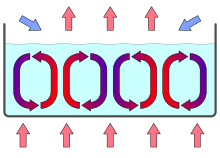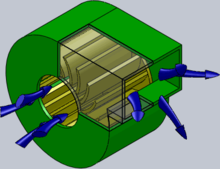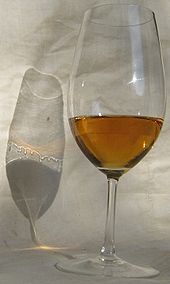Convection
![]()
This article has been entered into the Physics Editor's Quality Assurance. If you are familiar with the topic, you are welcome to participate in reviewing and possibly improving the article. The exchange of views on this is currently not on the article discussion page, but on the physics quality assurance page.
![]()
The articles Chimney Effect, Convection, Convection (Heat Transfer), Heat Transfer and Natural Convection overlap thematically. So information you are looking for here may also be in the other articles.
You are welcome to participate in the relevant redundancy discussion or to help directly to merge the articles or to better distinguish them from each other (→ Instructions).
Convection (from Latin convehere 'to bring') or flow transport is the transport of physical state variables in flowing gases or liquids. Physical state variables are, for example, entrained heat, matter or momentum. The convective transport of thermal energy is a mechanism of heat transport and is also called heat entrainment.
If static buoyancy occurs as the cause of the flow due to temperature differences, this is called thermal convection, natural convection, free convection or heat flow. In addition, the flow can be caused by pumps or fans, for example, or by thermodynamic imbalances, this is called forced convection.
In the Anglo-Saxon language, convection refers in a broader sense to any movement of molecules within a fluid and therefore includes, in addition to pure advection by flow, diffusion by movement at the atomic level (i.e. within fluids or solid matter).

Convection cells in a vessel heated from below
Mechanisms
Static buoyancy
→ Main article: Natural convection
Differences in density in the fluid lead to static buoyancy in the gravitational field. The density differences can be caused by a temperature difference or different substance densities. The motion driven in this way is called natural or free convection.
If the density differences are caused by different substance densities, this is called chemical convection, in the case of solutions also solutal convection, in the case of salt solutions also haline convection or in connection with thermal convection also thermohaline convection. If the density differences are caused by an accumulation of microorganisms on the surface of the liquid, this is called bioconvection.
Examples
Water is heated in a pot on the stove. At the bottom is heated, the side walls are insulated and at the surface the water cools down by evaporation or the outside temperature. Due to heating, water with lower density rises, water cooled at the top sinks. Convection-cells come up, like schematic shown at upside picture. Such an arrangement is called Rayleigh-Bénard-convection.
In meteorology, numerous phenomena are related to natural convection:
- In thermals, air on the ground is heated and rises.
- Rising moist air can cause cloud formation (especially cumulus and cumulonimbus) and thunderstorms.
External mechanical impact
→ Main article: Forced convection
When the flow is driven by forces outside the fluid, it is called forced convection. This occurs, for example, with pumps or fans.
If there are temperature and thus density differences in forced convection, the same forces also act as in free convection. The Archimedes number then indicates the ratio of free to forced convection.
Example
A circulation pump transports hot water from the heating system to the radiators.
Magnetohydrodynamics
Magnetic and electric fields can act as further driving forces. This is formulated mathematically in magnetohydrodynamics.
Examples
- The earth's magnetic field is generated by the dynamo effect.
- The structure of the Sun's corona, in particular sunspots are explained with the MHD.
Surface tension (Marangoni convection)
Marangoni convection is the term used to describe a flow that results from the gradient of the interfacial tension. The cause of the different interfacial tension can be, for example, a temperature gradient or concentration gradient of dissolved substances along the interface. In this case, the fluid flows along the interface in the direction of the greater tension. The Marangoni number, which can be understood as the ratio of interfacial tension to viscosity, is suitable as a key figure for characterizing Marangoni convection.
Examples
Marangoni convection can be observed when small soot particles float in the liquid wax of a candle. Near the flame, the surface of the liquid wax is hotter than further out at the edge of the candle. Since in general the interfacial tension decreases with increasing temperature, the interfacial tension close to the flame is lower than at the edge of the candle. As a result, the surface is torn outwards, taking with it wax close to the surface, which is thus driven to move in a circular motion. This becomes visible through the soot particles.
Another well-known example are the so-called tears of wine. Due to adhesion, a thin film of liquid creeps up the surface of the glass. As alcohol evaporates faster than water, the alcohol concentration decreases towards the top and thus the surface tension increases, further liquid flows in until gravity prevails. Discharging liquid with high surface tension contracts into narrow rivulets as it passes through the zone with low surface tension.
The Marangoni effect plays a significant role in the stabilization of liquid foams. Here, the gradient of the surface tension induced by a disturbance of the foam film surface causes a convective flow of the interlamellar liquid healing the disturbance.
The Marangoni effect is also important for processes in metal processing with high temperature gradients, such as in semiconductor production or welding.

Radial fan

The Marangoni effect causes the tears of wine, which are clearly visible here in the shadow of the wine glass.
Mathematical description
The substantial derivative in a fluid is composed of the local derivative and the convective derivative. Due to the chain rule, for a fluid property 
In this form the convection term occurs especially in the convection-diffusion equation.
Specifically, in the Navier-Stokes or Euler equations 


Questions and Answers
Q: What is convection?
A: Convection is the movement of heat caused by the movement of warm matter.
Q: How does atmospheric circulation affect wind?
A: Atmospheric circulation moves warm air to cool places, which causes wind.
Q: Can wind cool a room if a window is open?
A: Yes, wind can enter and cool a room if the window is open.
Q: What are some examples of convection?
A: Some examples of convection include the movement of clouds, ocean currents, and many types of heaters.
Q: Does convection only occur in gases?
A: No, convection can occur in liquids and even solids as well.
Q: How is convection different from conduction?
A: Convection involves the movement of matter, while conduction involves the transfer of heat through direct contact.
Q: How does convection impact our daily lives?
A: Convection impacts our daily lives in many ways, including the weather, the movement of air in our homes and buildings, and even the cooking of our food.
Search within the encyclopedia
